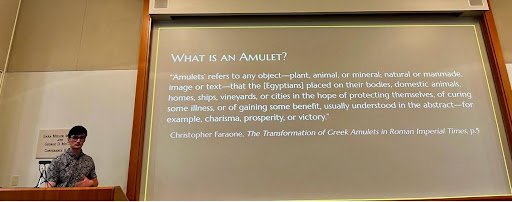By Bikalpa Chakraborty
Amulets in ancient Egypt did much more than just decorate the necks and wrists of their wearers — they were essential tools believed to protect against illnesses and evil forces, said historian Evan Axel Andersson at the 2024 Van Gelderen Lecture, hosted by UC Santa Barbara’s History Department.
Andersson brought this ancient world to life in his lecture, “Protect the One Who Carries You: Amulets and Daily Life in Roman Egypt.” A packed room of historians, alumni and guests gathered for the event, which showcases a Ph.D. student’s work and is named for the late UCSB donor Jo Beth Van Gelderen. It was co-sponsored by UCSB History Associates, which brings alumni and members of the larger community together with UCSB faculty.
UCSB History Ph.D. student Evan Axel Andersson explains the diverse uses of amulets in ancient Egypt, from protection to prosperity.
Andersson delved into the mystical world of Roman Egypt, describing amulets as “personal guardians.” They were viewed as protective entities that individuals carried with them to safeguard against harm, both physical and spiritual. Anderson said these items featured designs and writings that blended Egyptian, Hellenistic, and Christian traditions, showing a rich mix of cultural and religious influences.
Andersson’s presentation delved into the lives of ancient residents of ‘Oxyrhynchus,’ a city situated 130 miles south of modern Cairo. A Ph.D. candidate at UCSB, Andersson investigates the nuanced interplay of philosophy, spirituality, and society across the Mediterranean and the Middle East from the 1st to the 5th century CE. He researches the extensive collection of papyrus fragments that were unearthed in the region from the late 19th century to the present day.
The slide shows an ancient fever cure amulet inscribed to 'Relieve Plousios from the shivers,' highlighting historical medical practices in Roman Egypt.
One artifact Andersson discussed was a fever amulet from the 3rd century, believed to have held the power to stop shivers. “This entity is clearly powerful, but it is also supernatural, that is, it is beyond our world,” Andersson noted. He stressed how deeply intertwined spiritual beliefs and health practices were in Roman Egypt, saying that such amulets were not merely ornamental but vital to addressing the existential and religious concerns of the people at the time.
Amulets were used not just for protection and healing, Andersson said, but also to call upon divine help in daily life through special chants. This use of amulets shows a deeper layer of religious identity and practice among ancient wearers, which challenges modern misconceptions about the role of amulets in Christianity. He said contemporary society often view amulets solely as “pagan or superstitious artifacts,” which overlooks their significant spiritual and symbolic meanings within religious contexts, including in early Christianity.
This striking red jasper gem, shown in Evan Axel Andersson’s recent Van Gelderen history lecture, depicts Hercules in his legendary battle against the Hydra. This artifact, from the collections of Oxyrhynchus, illustrates the artistic melding of myth and material in Roman Egypt.
In his presentation, Andersson introduced another artifact: a red jasper gemstone carved with an image of Hercules fighting the Hydra, a mythical many-headed serpent. This depiction is unique and unusual, differing from the themes typically found on such artifacts. The gemstone might symbolize healing powers or represent a victory over overwhelming challenges, reflecting the broad spectrum of beliefs held by the people in late Roman Oxyrhynchus, he said. This city was a cultural crossroads where traditions from Greek, Egyptian, Jewish, and Christian backgrounds intermingled, creating a complex and diverse society.
The lecture attracted a wide array of experts and enthusiasts. “My husband and I were interested in this lecture because of our fascination with medieval history,” said Amanda Frost, a medieval historian and UCSB alumna.
Thomas Riley, a computer science engineer with a passion for ancient history, said the talk showed the intersection of past and present technologies.
“It is fascinating to see how modern technology can reveal so much about these ancient objects,” Riley said.
The UCSB History Department plans to make a detailed summary and multimedia presentation that highlights Andersson’s research.
Bikalpa Chakraborty is a third-year UC Santa Barbara student majoring in Communication. She covered this event for her Digital Journalism course.




